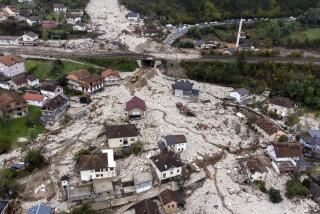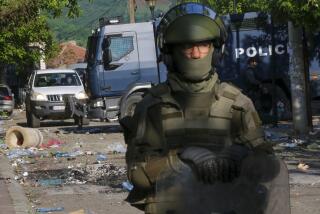Serbian Forces Press Fight for Major Chunk of Croatia
VIDUSEVAC, Croatia — The commander of the Croatian defense forces in Glina is actually no longer in Glina. He is here, across the river, beyond a wide, green valley, his dubious redoubt since last Friday.
“We did not abandon Glina,” he said. “We pulled out for reasons of safety.” That’s one way to put it. “Rout” is another word that comes to mind, although it is not in commander Bogdan Vajagic’s vocabulary.
For the record:
12:00 a.m. Aug. 3, 1991 For the Record
Los Angeles Times Saturday August 3, 1991 Home Edition Part A Page 2 Column 6 Foreign Desk 2 inches; 55 words Type of Material: Correction
Yugoslavia--An article Thursday on Yugoslavia overstated the size of the Krajina region of Croatia. The Krajina is best described as an archipelago of ethnic Serbian communities scattered across Croatia’s border region with Bosnia-Herzegovina and Serbia, which also includes some Croatian-dominated communities. By most estimates, the Krajina totals less than one-third of Croatia.
In spare moments, of which he seems to have many, he is given to peering through the shutter slats of his command post--the rectory of a small, baroque Catholic church, perched temptingly on the crest of a hill--training his binoculars on a Yugoslav federal army tank on the opposite distant slope, its gun pointed directly at him.
“I disagree with my government,” Vajagic said, still eyeing the tank through his field glasses. He meant his government in Zagreb, the Croatian capital, where the politicians decreed in June that Croatia should secede from Yugoslavia. “We should simply admit that this is a war between Serbia and Croatia. It is a war for territory.”
There is no longer any doubt that the Croatian commander’s assertion is true. What is going on now in Croatia is a war--a steady, step-by-step, armed campaign--and it is being fought by the Serbs, in a variety of military and paramilitary units, with the goal of wresting away a large chunk of what has been Croatian territory and joining it to Serbia.
The campaign has been progressing steadily for nearly two weeks, and by now it looks increasingly as if the Croats are being roundly whipped. Serbian units, charged up and scenting victory, and helped by the Yugoslav federal army (by fact if not by actual design), are slicing off more Croatian territory, towns and villages, every few days.
The end game for the Serbs and Croats in this fight is not yet perfectly clear, but the general sense is that when Serbia gains sufficient territory on the ground, it might then agree to talks with the aim of a sharp reduction in the map of Croatia and a significant gain for Serbia, including all the land that Serbian hard-liners refer to as “Krajina.” At its most extreme, the ethnic Serbian region of Krajina is considered to be about two-thirds of what is now Croatia.
In the meantime, what the collapsing federation of Yugoslavia has on its hands is a thoroughgoing mess that it seems powerless to resolve.
The consternation is infecting the rest of Europe as well, with the European Community equally confounded about whether, or how, to impose a solution. The “Eurocrats” in Brussels have been debating whether to send observers (and if so, whether they should carry side arms). They decided Monday that the EC would send monitors only after a cease-fire is in place. This seems a moot point, since Serbia’s paramilitary commanders are in no mood to talk of cease-fires.
While the hand-wringing goes on in Brussels, daily battles are taking place in Croatia, with daily loss of life and property. Refugees are streaming out of towns and villages in the path of the fighting, some with vivid stories of brutality and murder.
It was Glina’s turn last week. Only 30 miles south of Zagreb, with a population estimated at 35% Croatian and 65% Serbian, it has been the scene of at least two earlier fights over control of the local police station. Units of the Yugoslav federal army moved in about a month ago and set up camp in the public park near the town center, its tanks parked ominously at all four corners.
Then, on Friday, Serbian units moved on the police station, still in the hands of Croatian defense forces. The army once again moved in. The soldiers may have acted, as they claim, to break up the combatants, but when the dust settled, the Croats, as commander Vajagic noted, decamped. Rapidly.
Vajagic said his casualties were light--two dead, two wounded. At least two civilians were killed as well, among them a German reporter, hit by sniper fire on the road out of Glina. Journalists who were in the town said the fighting was fierce and frightening, with mortar shells raining down heavily.
Four days later, a weekday, Glina seemed virtually deserted. Only one or two thousand of the population of 10,000 appeared to be around. Shops were closed, houses were shuttered. The army was still bivouacked on the town square.
Up in his command post next door to the church, its wall hit by tank or mortar fire, Vajagic appeared to be waiting, with no clear plan in mind. Indeed, that seemed true of the whole of Croatia’s ragtag defense force this week, as yet another defense minister was appointed, replacing the last one, who had been in office just a month. Vajagic tries to put a good face on it.
“We still have the left bank of the river,” he said, “and we control the road from here to Glina.” That mile-long stretch of road, however, has so far been uncontested, and the Croats seem to have little to defend it should the Serbs decide to move. Three members of Vajagic’s unit maintain a checkpoint on the road--two men in their early 20s and a man at least 60, armed only with assault rifles. A sniper’s rifle, with telescope, leaned against a garage wall.
“It could happen any time,” said one of the young men when asked if he expected an assault. The surrounding countryside was lush and quiet, with larks singing in the hazy sun. Was this, really, a war? he was asked. “Yes,” he said, “it’s a dirty war.”
Just 35 miles to the south, the scene has been very different in the headquarters of the Serbian command in the town of Dvor. From this bucolic village, for the last three days, a steady, hammering assault has moved northeastward through even smaller hamlets--Struga, Uncani, Goluborac, Divusa--and so on, up the Una River in the direction of Kostajnica, a town of about 10,000. The Serbs had clearly put Kostajnica on their short list.
“Lots of Croatian police units in Kostajnica--for one or two more days,” said an officer of a Serbian unit that calls itself the “Seventh Banija Shock Division,” the name of a famed partisan unit from World War II.
The officer, in camouflage gear, black beret and black scarf, had come striding into a conference room in the local police station in the company of several other officers and aides, all bristling with lethal hardware. The officer, who would not give his name, carried an AK-47 (with two magazines taped together for easy reloading), two .45-caliber semiautomatic pistols wedged beneath his considerable stomach, two grenades in each breast pocket and two more hanging off his belt, next to a 10-inch hunting knife.
Trailing him was an aide or bodyguard lugging a .50-caliber machine gun, cartridge belts bandoleered in a great brass “X” across his chest. He propped the tripod on the upstairs window sill and trained the muzzle on the parking lot, as if he were expecting his comrades below to come under sudden attack. If so, they appeared equally well prepared.
Swarming around Dvor in recent days has been a bewildering array of Serbian units, all evidently eager to join the action. In addition to the federal army, with its somewhat ambiguous role, and the Seventh Banija Shock Division, there are the Krajina Territorial Force, the Krajina militia, the Krajina police and “Capt. Dragan’s” SAO Krajina “Kninjas.” SAO is the acronym for Serbian Autonomous Province (of Krajina), and Knin is the name of the town near the Croatian coast where it is based. The competitive atmosphere of machismo, thus assembled, might give Rambo pause.
The shadowy Capt. Dragan--no last name given--is Serbia’s new war media star and was seen on television over the weekend, swaggering about with a riding crop, urging tanks into battle up the road from Dvor, pointed toward Kostajnica. The series of victories over the tiny towns along that road have been billed as Capt. Dragan’s first campaign and a great triumph.
On Wednesday, he registered another one. Croatian radio reported that after days of strafing by federal air force jets and pounding by mortar fire, Croatian police and national guard forces had abandoned Kostajnica. A convoy several miles long, consisting of Croatian fighters and hundreds of frightened villagers, was reported moving slowly from Kostajnica toward the industrial city of Sisak, 18 miles away.
Not many among the Serbian units have been giving much thought to what will happen when the campaign is finished and what is to happen to Croats who live in villages split 60-40, or 40-60, between Croats or Serbs. Marjan Janosevic, 30, a lawyer and the vice president of the district council of Dvor, wearing a pistol on his belt, tried to be diplomatic.
“Those Croats who left will certainly need to come back,” he said. “But those who left with arms, who were given weapons by the Croatian police, they will probably not be welcome back. These were not hunting weapons. These were Kalashnikovs, and they were used to kill Serbs.”
More to Read
Sign up for Essential California
The most important California stories and recommendations in your inbox every morning.
You may occasionally receive promotional content from the Los Angeles Times.










